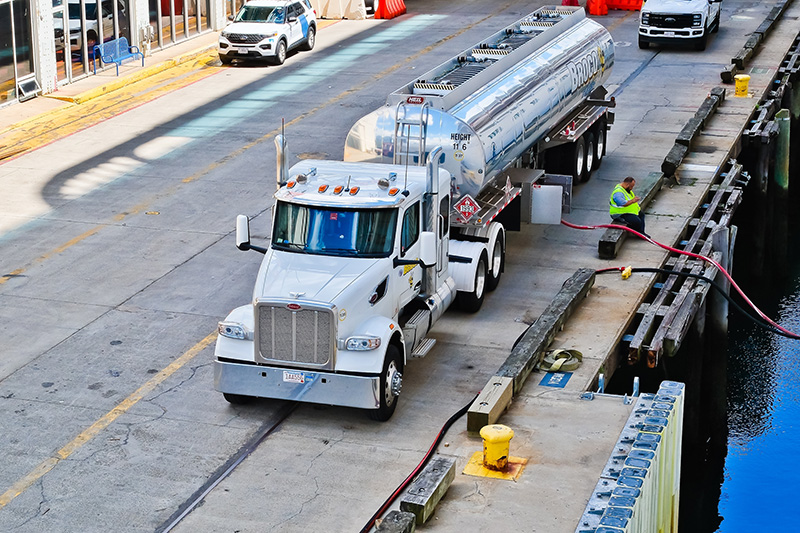A bulk carrier was loading cargo in port and planned to receive bunker fuel from shore trucks. The Chief Engineer completed the bunkering checklist. Initially, the plan was to load fuel into Tank 2 (port) to 96% capacity. However, just before loading began, the Chief Engineer decided instead to bunker Tanks 3 (port and starboard) to 90% each. Notably, the No. 3 tanks were half the size of the No. 2 tanks. The bunker system was lined up to supply Tank 3 port. Deck scuppers were put in place, and the Chief Engineer met with the truck driver to establish basic hand signals before connecting the hose to the vessel’s manifold.
Because the Chief Engineer felt the automatic sounding system in the engine control room was not sufficiently accurate, he arranged for the Third Engineer to take manual soundings on deck. An oiler assisted the Third Engineer. Near the manifold, a deck fitter and another oiler stood by, maintaining visual contact with the truck driver. The Chief Engineer remained on deck to monitor operations, while only one oiler was stationed in the engine room.
The sounding pipe for Tank 3 port was located near the superstructure. The Chief Engineer instructed the Third Engineer to switch to the starboard tank once Tank 3 port reached 80%. The Third Engineer measured the soundings approximately every six minutes. When Tank 3 port was near 80% capacity by the Third Engineer’s calculations, he went to the engine room to open the valves for Tank 3 starboard and close the valve for Tank
3 port. He did not inform anyone on deck or the truck driver that he was making this switch.
The hydraulic butterfly valves in question are located in the engine room but are controlled by a computer in the engine control room. The Third Engineer did not verify the position of the valves themselves to ensure Tank 3 port was fully shut. Instead, he checked that oil was entering Tank 3 starboard by monitoring the automatic sounding system, which showed an increasing level in the starboard tank. After returning to the deck, the Third Engineer started taking soundings on the starboard tank only, neglecting further checks on the port tank. Suddenly, the Chief Engineer, who
was on deck, noticed oil flowing from the air vent of Tank 3 port. He shouted and signalled the truck driver to stop the bunkering operation. However, before the driver could stop, some oil had already overflowed into the harbour.
The Chief Engineer immediately alerted the Master, who sounded the general alarm to muster all hands on deck to manage the pollution. The port authorities were also notified. The Third Engineer hurried back to the engine room to recheck the valves. He opened the valves to the settling tank and began pumping oil from Tank 3 port into the settling tank. It was later discovered that the valve to Tank 3 port had not fully closed, allowing oil to continue entering the tank until it overflowed.
Questions
When discussing this case please consider that the actions
taken at the time made sense for all involved. Do not only
judge but also ask why you think these actions were taken
and could this happen on your vessel?
- Does our SMS address these risks?
- What sections of our SMS would have been breached, if any?
- How can we ensure that all involved parties (engineers, deck crew, truck drivers) are immediately informed when any significant change (e.g.,switching tanks) is made during bunkering?
- How can we improve the reliability of both manual
soundings and the automatic tank monitoring
system to reduce the likelihood of overflow? - Are our current bunkering checklists comprehensive
enough, or do we need to update them to address
potential last-minute changes and communication
lapses?
- In the event of a spill, do all crew members
understand their specific roles and responsibilities?
How can we further enhance our response time and
coordination? - What process should be followed to assess the risks
whenever we deviate from the initial bunkering plan,
and how do we ensure everyone is aware of that
deviation? - What additional training or practical drills (e.g.,
valve checks, emergency stops, spill containment)
could help the crew be better prepared for real-life
scenarios? - What support do we need from management
(additional training, updated procedures, more
resources) to strengthen our bunkering procedures? - What immediate, actionable steps can we take from
today’s discussion?

MSS Case December: Pollution during bunkering from trucks
A bulk carrier experienced an oil overflow during bunkering when the Third Engineer switched tanks without informing the deck team and failed to verify that the valve to the original tank had fully closed. (Editorial credit: Yingna Cai / Shutterstock.com)
Editorial credit: Yingna Cai / Shutterstock.com
For more Loss Prevention information, please contact:
Joakim Enström, Loss Prevention Officer
E-mail: joakim.enstrom@swedishclub.com
Each month, the Club’s Loss Prevention team issues a new safety scenario to assist members in their efforts to comply with international safety regulations and follow best practices.